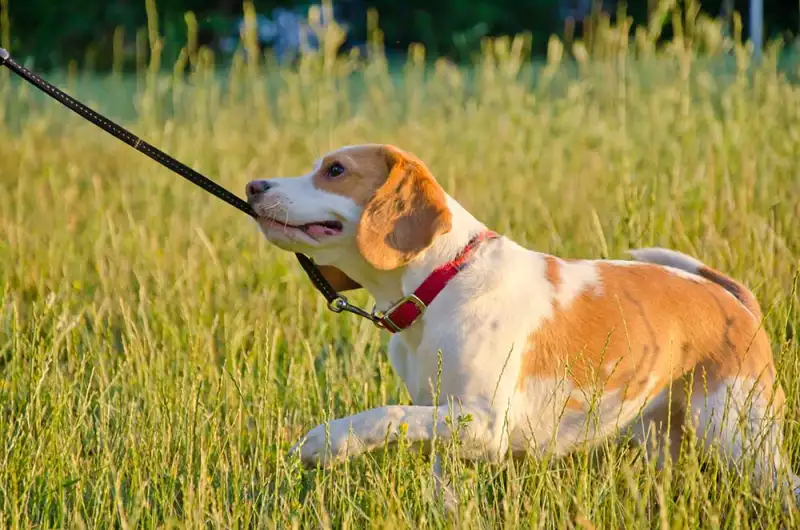One of the most common complaints among dog owners is leash-pulling. We all dream of the day our dog can walk perfectly by our side—no yanking, no leash wrapping around strangers’ legs, and no tug-of-war tussle on the sidewalk… As frustrating as this behavior may be, it helps to remember that walks are typically the most exciting times of the day for a dog. They’re naturally keen to explore all the new smells and people, but it can be difficult to know how to keep that enthusiasm in check. So check out our tips below to learn how to stop your dog from pulling on the leash!

1. Use positive reinforcement techniques
Almost all vets agree that positive reinforcement training give you the best results when you’re training your dog. Positive reinforcement essentially involves rewarding the good behavior you’d like to see (your dog walking calmly beside you), instead of punishing negative behavior you don’t want (leash-pulling).
Whenever your dog displays good behavior on walks, immediately praise her and give her a treat. That way she’ll link walking calmly with pleasant rewards.
2. Don’t pull back.
The biggest mistake when dealing with leash-pulling is responding by pulling or yanking your dog back towards you. Counterintuitively, this actually teaches your pup to pull harder, due to something known as the oppositional reflex.
When pulled in one direction, the body’s natural reaction is to lean or pull in the opposite direction in order to stay balanced. So when an owner pulls on the leash, the dog pulls harder in the other direction to maintain her balance. And that’s definitely not what you want.
3. Stay still.
When your dog starts pulling, stop and stand still. Don’t pull back on the lead—just stand still and keep the leash tight.
Eventually, your dog should look back at you. Praise and reward her with a treat, then proceed on your walk. If she starts pulling again, repeat the process. You won’t get very far on this walk, but consider it a training session rather than a walk for exercise purposes.
If your dog doesn’t look back at you or stop pulling, then you can break it down further; praise when the leash slackens even a little. And if she’s still distracted, try making a small noise to get her attention. Eventually, your dog should begin to get the right idea.
4. Mix it up and make it fun!
Give your dog a reason to pay closer attention to your movements by being unpredictable. Stop and change direction, and when your dog turns to catch back up, reward her.
You can turn it into a game — when your dog runs toward you, use a super-excited voice, give her lots of praise, and make it fun for her to follow you.
5. Be consistent and patient.
Being consistent is really important when it comes to eliminating leash-pulling. Try to let your dog walk only when the leash is slack to really embed the new habit.
It may take a long time for your dog to be able to walk calmly for long distances; some people report it can take a week to walk even half a block successfully. So be as patient as possible, and if some areas are too distracting for your dog, avoid them until she’s built up some success with loose-leash walking.
Being consistent is really important when it comes to eliminating leash-pulling. Try to let your dog walk only when the leash is slack to really embed the new habit.
6. Give your dog time to just be a dog.
Dogs need time and space to do all the “dog things” they want to do on a walk, like having a good sniff and relieving themselves. You can control this by deciding when that time is.
Give your dog a signal, say “go sniff,” and give her a few minutes to be a dog. Then signal again when she needs to start paying attention and walking beside you again: “Let’s go.”
Having got some doggie urges out of her system, she should be a little calmer and better able to walk nicely beside you.
7. Consult a dog trainer.
Some dogs naturally struggle to learn good walking manners more than others, so if you’re still having problems after weeks of training attempts on your own, don’t hesitate to contact a dog trainer. Relying on their years of experience with all kinds of dogs, they’re going to be able to make walks more pleasant for both you and your dog.
Are there special collars to stop leash-pulling?
Yes! There are a number of collars and harnesses specifically designed to help with leash-pulling.
Head halters (a popular type is the “gentle leader” halter) are collars that fit around your dog’s nose and attach to the leash underneath the chin. When your dog pulls, her head is turned back around to you, discouraging her from pulling.
Similarly, chest-led or front-attachment harnesses can be useful. They are harnesses that attach to the leash at the chest, rather than on the dog’s back, so they also automatically turn the dog back to face you when pulling begins.
Just keep in mind that while these types of tools can help prevent leash-pulling, they’re not a substitute for good training. It’s also very important that you follow the manufacturer’s instructions to make sure they’re used correctly, as they can be dangerous for your dog if used incorrectly.
If your dog yanks very hard, we recommend using a harness, as leashes attached to neck collars may increase the risk of injury to the neck. In general, watch out for coughing or choking when your dog pulls, as this is a sign that they could injure themselves.
Lastly, we strongly recommend that you never use a choke chain, prong collar, or an electronic collar. They cause pain and distress to your dog, and they aren’t effective methods of teaching new behaviors.
Leash-pulling can be a difficult behavior to crack, but with patience and consistency, most dogs can learn to walk calmly by your side.
